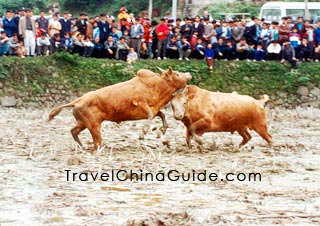Chinese Ethnic Minority Festivals
Water-Splashing Festival of Dai
- the most influential feast in Yunnan ProvincePlace: Yunnan Province
Activities: Regarded as the New Year of Dai ethnic minority, it is the traditional occasion for Dai and the most influential feast in Yunnan Province. Before the festival, pigs and chickens are slaughtered and wines are brewed with other foods also being prepared beforehand. During the three days of the festival, rich and colorful activities are held. Dragon boat racing and other performances such as Peacock dance are held on the first day followed by the characteristic water-splashing event on the second day. The last day is usually for the young people to play games as a way of expressing their love for each other.
Usually held by the banks of the picturesque Lancang River (one of the main rivers of southwest China), girls of Dai ethnic minority dip branches into the river and sprinkle the water onto others as a way to express their best wishes at the beginning. The climax of the water-splashing activity is when the people of the different ethnic groups attending the it and splash water upon each other, using basins and buckets. Although all the people are soaked to the skin, all participants are happy.
Torch Festival of Yi
- the most ceremonious minority dancePlace: Sichuan Province
Activities: Recognized as the grandest traditional festival of the Yi ethnic minority, it is full of rich and colorful activities. Worshiping ancestors, visiting relatives and friends to convey their best wishes are the main events of the first day. Bull and sheep fighting, horse racing, cockfighting, singing competition, beauty contest, wrestling and tug-of-wars etc. are held on the second day allowing everyone to compete and play to their heart content.
The climax comes in the evening of the third day, large bonfires are lit while people sit, sing, and dance around them the whole night. In the eyes of the Yi, the torch symbolizes happiness and chasteness and brings good luck to the people. Because the festival is of such a frantic and ardent atmosphere, people from other countries refer to it as 'the Carnival with Chinese Characteristics'.
Knife-Pole Festival of Lisu
- the most breathtaking minority galaPlace: Yunnan Province
Activities: As a traditional gala of Lisu ethnic minority, the Knife-Pole Festival expresses good wishes to everyone of the Lisu. A phrase describing bravery in China goes like this, 'climbing the Knife Mountain and diving into the Fire Sea' and the Knife-Pole Festival is a vivid depiction of this. On the eve of the festival, a grand bonfire is set alight with people dancing around it, later, some of the bolder men leap in the fire, extinguishing it barefooted. It is widely believed that through this act all manner of disasters will be averted.
In the middle of the 2nd day of the second lunar month, the other activity, which represents 'climbing the Knife Mountain' is the highlight of the festival and attracts numerous spectators. 20-meter-high poles, each affixed with 72 razor sharp knives are erected. After drinking a cup of wine, the warriors begin to ascend the pole via the sharpened blades. Upon reaching to the top, they are rewarded with impassioned applauses, whilst they light firecrackers and throw small red flags to the crowds, showering good luck upon everyone. The remainder of the day is for the young, throwing pouches to each other to show love. Nowadays, climbing poles via knives as rungs is recognized as the traditional sport of the Lisu people.
Bullfight Festival of Miao
- the most famous bullfight activity |
| Bullfight Festival of Miao |
Date: 25th day of the first lunar month
Place: Guizhou and Yunnan Provinces
Activities: The Miao ethnic minority people are primarily farmers and have come to regard cattle as an indispensable ally, assisting them in all aspects of their daily lives. When the traditional Bullfight Festival comes, hosts feed their cattle well, even giving them wine in the hope that they will perform well. The event is usually held on an even meadow with the Miao people being well dressed on this auspicious occasion.
There are several alternative bullfights: two bulls and up to several bulls fighting etc. When two fight with each other, the result is usually determined within three to five minutes' fierce combat. However, it is only in the last round that decides which Bull is the winner; it may last more than half an hour. During the fight, audiences around the meadow shout loudly making the festival immersive in a fiery scene. Red silk sashes and flowers adorn the first prize bull with food being the Bulls reward. With bonfires being lit within the bullfighting ring whilst the young men play Lusheng (a homemade reed mouth organ with five or six pipes, played by various ethnic groups in southwest China) girls dance for the whole night. By holding the Bullfight Festival, Miao hope for a favorable harvest in the coming year and good health.